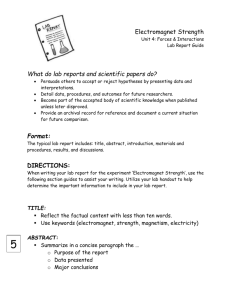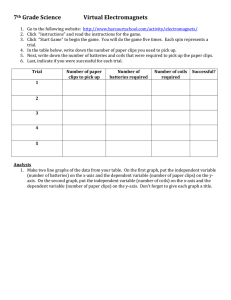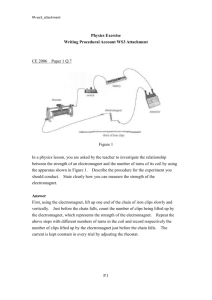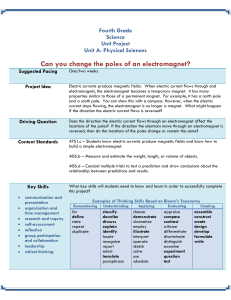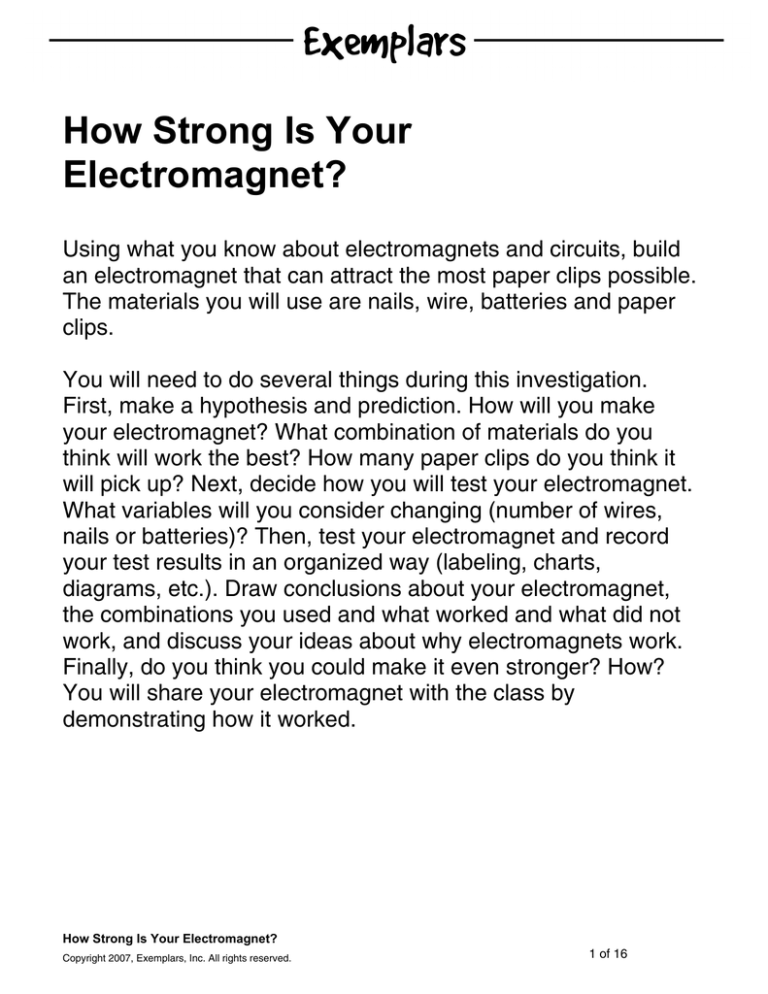
How Strong Is Your
Electromagnet?
Using what you know about electromagnets and circuits, build
an electromagnet that can attract the most paper clips possible.
The materials you will use are nails, wire, batteries and paper
clips.
You will need to do several things during this investigation.
First, make a hypothesis and prediction. How will you make
your electromagnet? What combination of materials do you
think will work the best? How many paper clips do you think it
will pick up? Next, decide how you will test your electromagnet.
What variables will you consider changing (number of wires,
nails or batteries)? Then, test your electromagnet and record
your test results in an organized way (labeling, charts,
diagrams, etc.). Draw conclusions about your electromagnet,
the combinations you used and what worked and what did not
work, and discuss your ideas about why electromagnets work.
Finally, do you think you could make it even stronger? How?
You will share your electromagnet with the class by
demonstrating how it worked.
How Strong Is Your Electromagnet?
Copyright 2007, Exemplars, Inc. All rights reserved.
1 of 16
How Strong Is Your Electromagnet?
Suggested Grade Span
3–5
Task
Using what you know about electromagnets and circuits, build an electromagnet that can attract
the most paper clips possible. The materials you will use are nails, wire, batteries and paper
clips.
You will need to do several things during this investigation. First, make a hypothesis and
prediction. How will you make your electromagnet? What combination of materials do you think
will work the best? How many paper clips do you think it will pick up? Next, decide how you will
test your electromagnet. What variables will you consider changing (number of wires, nails or
batteries)? Then, test your electromagnet and record your test results in an organized way
(labeling, charts, diagrams, etc.). Draw conclusions about your electromagnet, the combinations
you used and what worked and what did not work, and discuss your ideas about why
electromagnets work. Finally, do you think you could make it even stronger? How? You will
share your electromagnet with the class by demonstrating how it worked.
Big Idea and Unifying Concept
Cause and effect
Physical Science Concepts
Motion and forces
Properties of matter
Transfer and transformation of energy
Mathematics Concepts
Data collection, organization and analysis
Graphs, tables and representations
Measurement
Time Required for the Task
Approximately two 45-minute sessions.
How Strong Is Your Electromagnet?
Copyright 2007, Exemplars, Inc. All rights reserved.
2 of 16
Context
Students have had a number of experiences with circuits and lighting bulbs. They have also
built an electromagnet using one wire, one nail and one battery. The students found this
electromagnet to be quite weak, and the essential question for this task came from the students
themselves. They wanted to make a strong electromagnet. They already understand the idea
that a circuit is needed to create electromagnetism.
What the Task Accomplishes
This task accomplishes several things. It reinforces the concept of circuits and allows students
to apply and extend their knowledge of circuits in a new way. It also introduces the idea of
magnetism and attraction, which will later be explored further using regular magnets. It can also
be used as an assessment of students’ understanding of circuits as well as of their science
process skills. These skills include making predictions and hypotheses, drawing and labeling
diagrams, testing and recording data, controlling variables and drawing conclusions.
How the Student Will Investigate
Before beginning this task, we review what a circuit is, how students made one to get light bulbs
to light, and how they made one to create an electromagnet. Because students raised the
question themselves about making a stronger electromagnet, they were highly engaged in this
task and had many ideas. We discussed several possibilities before beginning in order to help
students narrow down their ideas and focus their investigation. We also discussed how they
would know if their electromagnet was successful. How many paper clips would that take?
Students could work individually or in small groups. Students could then decide on the number
of paper clips to work toward. They then were able to write their hypotheses and predictions.
Next, they decided what variables they would change if their idea was unsuccessful. They
needed to make sure that they organized all this information and data so that their conclusion
would accurately reflect what they did and what they learned.
Interdisciplinary Links and Extensions
Science
Magnetism is a concept that fascinates children. There are many extensions you can explore
with this topic. Allow students the opportunity to investigate using regular magnets of all sizes
and shapes. Which ones are the strongest? How long does something stay attracted? What
kinds of things do magnets attract? Another possible extension might be to investigate electric
motors that use the ideas of circuits and magnets to make a motor work. The AIMS Education
Foundation's module on electricity has many wonderful ideas.
Social Studies
Students can research electricity and magnets, how they were discovered, their uses and how
they have changed our lives (through machines that use magnets and electromagnetic motors,
for example). Research findings can be presented to the class.
How Strong Is Your Electromagnet?
Copyright 2007, Exemplars, Inc. All rights reserved.
3 of 16
Technology
Students can take apart machines that use electric motors and magnetism to work. Machines
such as blenders, mixers, vacuums, etc., can all be used for this. Students enjoy taking things
apart, looking for an electromagnet inside, and seeing what makes the machines work. This
also helps students to make some real-world connections between what they are learning in
schools and how it is used in our lives.
Teaching Tips and Guiding Questions
It is important to make sure that students have a good understanding of circuits before
beginning this task, or they might get frustrated. They also need to have had experience
exploring with the materials and to have made an electromagnet previously. Here are some
questions you can ask to help guide students' thinking:
•
•
•
•
•
•
•
•
•
•
•
•
•
•
•
What ideas do you have about circuits that will help you build a strong electromagnet?
Can you describe/trace the path that the electricity will take?
How will you build your magnet?
What materials and how much of those materials will you use?
What are the variables you will be controlling? changing?
If an idea is not successful, how will you change your magnet? What will you add? take off?
How many paper clips have you estimated will be attracted to your electromagnet?
What prior knowledge are you basing your estimate on?
What is happening to make your magnet work? Why does it work?
What did your learn from this about magnetism, electricity and circuits?
What happens to the magnet when you disconnect a terminal?
Is this a temporary or permanent magnet?
How might you make your electromagnet even stronger?
What would you need in order to do this?
Is there a difference in the magnet’s strength when the wire is wrapped with fewer/more
coils around the nail? With tighter/loser turns?
Concepts to be Assessed
(Unifying concepts/big ideas and science concepts to be assessed using the Science
Exemplars Rubric under the criterion: Science Concepts and Related Content)
Scientific Method: Students observe and explain cause-effect relationships, with some
justification, using data and prior knowledge, when variables are controlled (cause and effect).
Physical Science – Transfer and Transformation of Energy: Students explain that energy is a
property of many substances, is associated with electricity and magnetism and is transferred in
many ways. Students observe that an electrical current moves through a circuit in a continuous
path unless interrupted and that a circuit is a continuous path connecting bulb, wire and battery,
providing a means of transferring electrical energy.
How Strong Is Your Electromagnet?
Copyright 2007, Exemplars, Inc. All rights reserved.
4 of 16
Physical Science – Motion and Forces: Students observe that magnets come in a variety of
shapes and sizes (horseshoe, bar, round, etc.) and have a variety of uses, but they work in
similar ways. Students explain that a magnet has an invisible force field which can “go through”
some things or continue to attract an object depending on the distance between them, that the
current that moves through wire and nail creates a (temporary) magnetic force that attracts
certain objects (like paper clips) and that the more current that flows through a wire in a unit of
time, the more magnetism is generated around the wire.
Physical Science – Properties of Matter: Students observe physical properties and
characteristics of magnetic and nonmagnetic materials and make predictions and classify
materials. Students observe that only some materials (actually, the iron in some materials) are
attracted to magnets and conduct electricity.
Mathematics: Students use precise measurements. Students collect, organize and analyze
data and use graphs tables and representations appropriately.
Skills to be Developed
(Science process skills to be assessed using the Science Exemplars Rubric under the criteria:
Scientific Procedures and Reasoning Strategies, and Scientific Communication Using Data)
Scientfic Method: Observing, hypothesizing, predicting, drawing and labeling diagrams, testing
ideas, making observations, manipulating tools, recording, explaining, drawing conclusions and
communicating findings.
Other Science Standards and Concepts Addressed
Scientific Method: Students describe, predict, investigate and explain phenomena. Students
control variables.
Scientific Theory: Students look for evidence that explains why things happen and modify
explanations when new observations are made.
Physical Science – Motion and Forces: Students observe and record the effects of a magnetic
force on materials and combinations of materials. Students demonstrate that forces can act “at
a distance” and can cause objects to be pushed or pulled.
Physical Science – Transfer and Transformation of Energy: Students explain that energy is a
property of many substances and is associated with heat, light, electricity, mechanical motion,
sound, nuclei and the nature of a chemical. Students understand that an electrical current
moves through a circuit in a continuous path unless interrupted and that a circuit is a continuous
path, providing a means of transferring electrical energy. Students observe that magnetism is a
form of electrical energy.
How Strong Is Your Electromagnet?
Copyright 2007, Exemplars, Inc. All rights reserved.
5 of 16
Suggested Materials
For each group of students, I provide D-cell batteries, insulated copper wire cut into lengths of
at least 10 inches so that students can wrap these around the nails, galvanized steel nails
(these work the best and can be found at a hardware store) and small paper clips. You will
need to have a large number of each of these materials so that students can investigate their
ideas. Students will need to scrape the insulation from each end of the wire so that the copper
will make contact with the battery terminals to carry the electric current.
Possible Solutions
Students will find several ways to make a circuit that creates a strong electromagnet. They may
find that using more than one battery makes it stronger. They may also find that adding nails or
wrapping more wire works as well.
A good solution will include a hypothesis and prediction. It will include students' ideas about
controlling variables: what they will change and what they will keep the same. (The data chart is
the best way to assess this aspect from trial to trial.) It will have a detailed, labeled drawing of
their electromagnet. Their test results and data will be organized in some way, using a chart or
table to display their findings. Finally, their conclusions and interpretations will reflect their
learning during this investigation, include appropriate vocabulary and demonstrate their
understanding of the concepts.
Task-Specific Assessment Notes
Novice
This student includes a testable question and a prediction about how many paper clips the
electromagnet will pick up. There is a drawing (with a key) of the combination that was tried.
There is no hypothesis or discussion of the variables that were controlled or changed. There is
a chart with the data that are collected and the columns labeled. The chart reveals that more
than one variable (number of wires and number of nails) is changed in each of the three trials,
although the number of batteries is kept constant – evidence that the student does not
understand fully the importance and/or process of changing one variable at a time. The
conclusion includes one concept – using a complete circuit - yet we do not know how many
circuits are tried each time, nor whether the student verifies each individual circuit to be sure
s/he has three. This student also states that perhaps more batteries might make a stronger
magnet. More information is needed to demonstrate his/her understanding of the concepts.
Apprentice
This student includes the testable question, a hypothesis and a prediction. There is a labeled
diagram that also demonstrates the concept of magnetic force. The chart with data collection is
clear and organized, yet it reveals that the student changes more than one variable at a time.
This student includes some discussion of variables, what is changed and why it works. The
conclusion demonstrates understanding by discussing ideas about circuits and how electricity
moves through wire. This student then adds some thoughts about how s/he might make it even
How Strong Is Your Electromagnet?
Copyright 2007, Exemplars, Inc. All rights reserved.
6 of 16
stronger. [Had the student controlled variables appropriately, and re-tested for five batteries
(perhaps with newer batteries, since s/he discussed “don’t use dieing batteries”) this would
have been at the Practitioner level.]
Practitioner
This student includes the testable question, a hypothesis and a prediction. There is a welllabeled diagram of the electromagnet and a chart that contains the data gathered. Variables are
appropriately controlled (only the number of batteries changes each time). The conclusion
begins to demonstrate understanding of a complete circuit and of the force of magnetism
(“electricity moves through the wires”). This student also believes that more batteries would
mean greater magnetism and gives some reasons why some of the combinations do not work
(do not hold the wire tight enough). This hypothesis is an extension of what is tried in the
investigation.
Expert
This student includes the testable question, a prediction and a hypothesis with procedures fully
described. Within the hypothesis is evidence of use of prior knowledge and extended thinking –
a lot of information about why the idea will work and which variables are changed (number of
batteries), a discussion of concepts, and a reference to the theory of how more batteries make
a light bulb brighter, therefore making the electromagnet stronger. Appropriate vocabulary is
used throughout, variables are controlled, and additional trials with the same variables
conducted – evidence of conceptual understanding. There is a labeled and detailed drawing of
the electromagnet (one that works and one that does not) and a clear chart of the results
gathered. The conclusion begins to get at the big ideas of magnetism and electromagnets. At
the Expert level, I might also encourage a more detailed discussion of why variables are
controlled, why additional trials are conducted and what concepts are learned.
How Strong Is Your Electromagnet?
Copyright 2007, Exemplars, Inc. All rights reserved.
7 of 16
Novice
How Strong Is Your Electromagnet?
Copyright 2007, Exemplars, Inc. All rights reserved.
8 of 16
Novice
How Strong Is Your Electromagnet?
Copyright 2007, Exemplars, Inc. All rights reserved.
9 of 16
Apprentice
How Strong Is Your Electromagnet?
Copyright 2007, Exemplars, Inc. All rights reserved.
10 of 16
Apprentice
How Strong Is Your Electromagnet?
Copyright 2007, Exemplars, Inc. All rights reserved.
11 of 16
Practitioner
How Strong Is Your Electromagnet?
Copyright 2007, Exemplars, Inc. All rights reserved.
12 of 16
Practitioner
How Strong Is Your Electromagnet?
Copyright 2007, Exemplars, Inc. All rights reserved.
13 of 16
Expert
How Strong Is Your Electromagnet?
Copyright 2007, Exemplars, Inc. All rights reserved.
14 of 16
Expert
How Strong Is Your Electromagnet?
Copyright 2007, Exemplars, Inc. All rights reserved.
15 of 16
Expert
How Strong Is Your Electromagnet?
Copyright 2007, Exemplars, Inc. All rights reserved.
16 of 16

